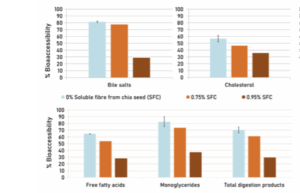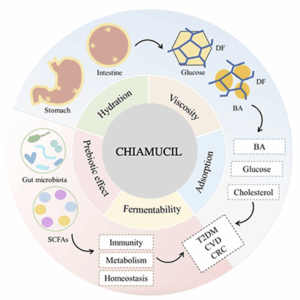Science on Key Health Benefits of Chia Fiber
Metabolic diseases like type 2 diabetes (T2D) and cardiovascular disease (CVD) are among the most important public health challenges in the world today. We have good epidemiological evidence linking higher fiber intake to a lower risk of T2D and CVD [2,3]. More recently, scientists are learning how dietary fiber intake may influence the development or prevention of these serious chronic diseases and other health conditions.
Prebiotic Effects
In recent decades, new knowledge has shed light on how the microbiome may play a role in developing chronic, systemic inflammation that may lead to diseases like T2D, CVD, and others [4, 5, 6, 7].
In humans, the gut microbiota has evolved through a symbiotic relationship with the host. It offers the host benefits through the protection it provides against pathogens. It also contributes to the host’s overall health by maintaining intestinal barrier integrity, contributing to nutrient production, and by producing metabolites such as short-chain fatty acids (SCFA) [8, 9].
A balanced bacterial composition in the gut is important for maintaining intestinal immunity and homeostasis [10]. Dietary components such as fiber play a key role in supporting this balance by influencing the gut bacteria composition and microbial-derived metabolites, which in turn influence host metabolism [11, 12].
Dietary fibers are categorized according to their structure; further classifications are made based on their water solubility, viscosity, and fermentability. Soluble fibers are a type of fiber that’s abundant in chia seeds.
Soluble fibers are fermented or metabolized by the gut microbiota into short-chain fatty acids (SCFAs) such as acetate, propionate, and butyrate [13, 14, 25]. Recent research shows that SCFAs play important roles in regulating metabolism. They enter the bloodstream and impact the metabolic process by binding to G-protein-coupled receptors (GPRs). GPRs are found in various bodily tissues and help regulate processes like glucose (blood sugar) control and lipid (fat) metabolism [18, 19].
SCFAs may help regulate gene expression by acting as histone deacetylase inhibitors. They also provide energy to intestinal cells and improve gut barrier function [11, 20]. That’s important for chronic disease risk: A stronger gut barrier helps prevent harmful microbes from entering the bloodstream, which can lower immune responses linked to metabolic diseases [21].
The soluble fiber in chia seeds has demonstrable effects on gut microbiota. The fiber is fermented by microbes in the small intestine, which yields the production of metabolites like SCFAs. The SCFAs may be absorbed into the host’s circulation and influence metabolic regulation [24].
In fact, some SCFA producers were reported to be significantly increased after the intake of chia fiber, including Enterococcus and Lactobacillus. This is in line with previous studies and indicates that certain types of soluble fibers, including inulin, beta-glucan, and galacto-oligosaccharides (GOS), may increase the abundance of SCFA-producing strains [25, 26, 27, 28]. Furthermore, increases in stool or plasma SCFA were evident after intake of chia fiber.
Evolution of Microbial Growth on Principal Bacterial Groups Population in the Digestive Tract During Chia Soluble Fiber Supplementation

Blood Sugar Control and Metabolic Health
Diabetes is a chronic disease affecting roughly 1 in 10 Americans. When a person has diabetes, their body isn’t able to properly process and use glucose (sugar) from the foods they eat.
There are different types of diabetes, but all share the common issues of too much glucose in the bloodstream and challenges in moving it where it needs to go. Chronic high blood sugar eventually damages the body and can lead to other serious health issues, including vision loss, nerve damage, kidney disease, and cardiovascular disease [19].
ChiaMucil is a rich source of soluble dietary fiber, which slows the digestion rate of nutrients like carbohydrates. This can support healthier blood sugar levels and potentially reduce the risk of type 2 diabetes (T2D). It may also support treatment for people with existing T2D [19].
Several studies have shown that increased fiber intake, especially intake of viscous or soluble fibers, reduces the glycemic index (GI) of foods or beverages. This slows the release of sugar into the bloodstream and blunts or even helps to prevent excessive insulin responses (or blood sugar spikes and crashes). Several studies also show that soluble fibers can reduce inflammation and improve insulin sensitivity, or the body’s ability to effectively use insulin to move sugar from the bloodstream into the cells, which can be used as energy [29, 30, 31, 32, 33].
These effects have been demonstrated for ChiaMucil specifically. Consumption of ChiaMucil has been shown to lower postprandial plasma glucose and insulin while improving insulin sensitivity in healthy individuals [34].
Chia also offers cardio-protective effects, which is especially important for people with diabetes, who are at higher risk for heart disease [35]. In a well-designed animal study, when chia was added to the diet, researchers saw significant reversals in insulin resistance, reduced triglyceride levels, and reduced abdominal fat compared to the control group [36]. When these indicators are within a healthy range, we see fewer secondary health issues in individuals with diabetes.
Bioaccessibility and Digestion of Glucose and Lipids After Soluble Chia Fiber Supplementation


Appetite Control and Weight Management
Chia seed consumption has been shown to help suppress appetite, as well as promote weight loss when eaten as part of a reduced-calorie diet [15]. Insoluble fiber physically fills up space in the stomach and intestinal tract, while soluble fiber slows the rate at which food is digested. Together, these properties help people stay fuller longer, and in turn, may support weight management. Chia seed’s soluble fiber consistency may also block a proportion of fats from food that would otherwise be digested and absorbed, further supporting weight loss [16].
Heart Health
Daily chia consumption is tied to a significant drop in LDL cholesterol and triglycerides, while chia flour consumption may help reduce blood pressure. Dietary fiber has long been known to reduce cardiovascular disease risk by blocking the absorption of some dietary cholesterol, and ChiaMucil’s unique nutritional properties give it a heart-health edge. In addition to being soluble fiber-rich, chia’s ALA omega-3 fatty acids and phytochemicals also exert cardio-protective effects [17, 18].
Cardiometabolic Effects and Health Benefits of ChiaMucil Fiber

References
[1] Veronese N, Solmi M, Caruso MG, et al. Dietary fiber and health outcomes: an umbrella review of systematic reviews and meta- analyses. Am J Clin Nutr. 2018;107(3):436-444.
[2] Quagliani D, Felt-Gunderson P. Closing America’s Fiber Intake Gap: Communication Strategies From a Food and Fiber Summit. Am
J Lifestyle Med. 2016 Jul 7;11(1):80-85. US Department of Agriculture. Dietary Guidelines for Americans 2020-2025. Accessed July 29, 2022. https://www.dietaryguidelines.gov/sites/default/files/2020-12/ Dietary_ Guidelines_for_Americans_2020-2025.pdf
[3] Barber TM, Kabisch S, Pfeiffer AFH, Weickert MO. The Health Benefits of Dietary Fibre. Nutrients. 2020 Oct 21;12(10):3209. Dahl WJ, Stewart ML. Position of the Academy of Nutrition and Dietetics: Health Implications of Dietary Fiber. J Acad Nutr Diet. 2015;115(11):1861-1870.
[4] Stephen AM, Champ MM, Cloran SJ, Fleith M, van Lieshout
L, Mejborn H, Burley VJ. Dietary fibre in Europe: current state of knowledge on definitions, sources, recommendations, intakes and relationships to health. Nutr Res Rev. 2017 Dec;30(2):149-190.
[5] Clemens R, Kranz S, Mobley AR, Nicklas TA, Raimondi MP, Rodriguez JC, Slavin JL, Warshaw H. Filling America’s fiber intake gap: summary of a roundtable to probe realistic solutions with a focus on grain-based foods. J Nutr. 2012 Jul;142(7):1390S-401S. Mobley AR, Jones JM, Rodriguez J, Slavin J, Zelman KM. Identifying practical solutions to meet America’s fiber needs: proceedings from the Food & Fiber Summit. Nutrients. 2014 Jul 8;6(7):2540-51
[6] Barber TM, Kabisch S, Pfeiffer AFH, Weickert MO. The Health Benefits of Dietary Fibre. Nutrients. 2020 Oct 21;12(10):3209.
[7] https://www.tateandlyle.com/news/ do-consumers-feel-enough-products-contain-added-fibre
[8] https://www.ucsfhealth.org/education/increasing-fiber-intake
[9] Khalid W, et al. Chia seeds (Salvia hispanica L.): A therapeutic weapon in metabolic disorders. Food Sci Nutr. 2022 Dec 15;11(1):3-16.
[10] Barber TM, Kabisch S, Pfeiffer AFH, Weickert MO. The Health Benefits of Dietary Fibre. Nutrients. 2020 Oct 21;12(10):3209.
[11] Diaz S, Bittar K, Hashmi MF, et al. Constipation. [Updated 2023 Nov 12]. In: StatPearls [Internet]. Treasure Island (FL): StatPearls Publishing; 2024 Jan-. Available from: https://www.ncbi.nlm.nih.gov/ books/NBK513291/
[12] Mishima MDV, et al. Chia Phenolic Extract Appear to Improve Small Intestinal Functionality, Morphology, Bacterial Populations, and Inflammation Biomarkers In Vivo (Gallus gallus). Nutrients. 2023; 15(16):3643.
[13] Khalid W, et al. Chia seeds (Salvia hispanica L.): A therapeutic weapon in metabolic disorders. Food Sci Nutr. 2022 Dec 15;11(1):3- 16. doi: 10.1002/fsn3.3035. PMID: 36655089; PMCID: PMC9834868.
[14] Xiong RG, et al. Health Benefits and Side Effects of Short- Chain Fatty Acids. Foods. 2022 Sep 15;11(18):2863. doi: 10.3390/ foods11182863
[15] Vuksan V, et al. Salba-chia (Salvia hispanica L.) in the treatment of overweight and obese patients with type 2 diabetes: A double- blind randomized controlled trial. Nutr Metab Cardiovasc Dis. 2017 Feb;27(2):138-146.
[16] Tamargo A, Martin D, Navarro Del Hierro J, Moreno-Arribas MV, Muñoz LA. Intake of soluble fibre from chia seed reduces bioaccessibility of lipids, cholesterol and glucose in the dynamic gastrointestinal model simgi®. Food Res Int. 2020 Nov;137:109364.
[17] Venezuela, R. “Chemical composition, nutritional characteristics, and benefits associated with the consumption of chia.”
[18] Toscano LT, et al. Chia flour supplementation reduces blood pressure in hypertensive subjects. Plant Foods Hum Nutr. 2014 Dec;69(4):392-8.
[19] Juangco, JR, et al. Effectiveness of Chia (Salvia hispanica L.) As an Adjuvant Therapy for Type 2 Diabetes Mellitus, a Meta-Analysis. 2021..
[20] Barber TM, Kabisch S, Pfeiffer AFH, Weickert MO. The Health Benefits of Dietary Fibre. Nutrients. 2020 Oct 21;12(10):3209.


